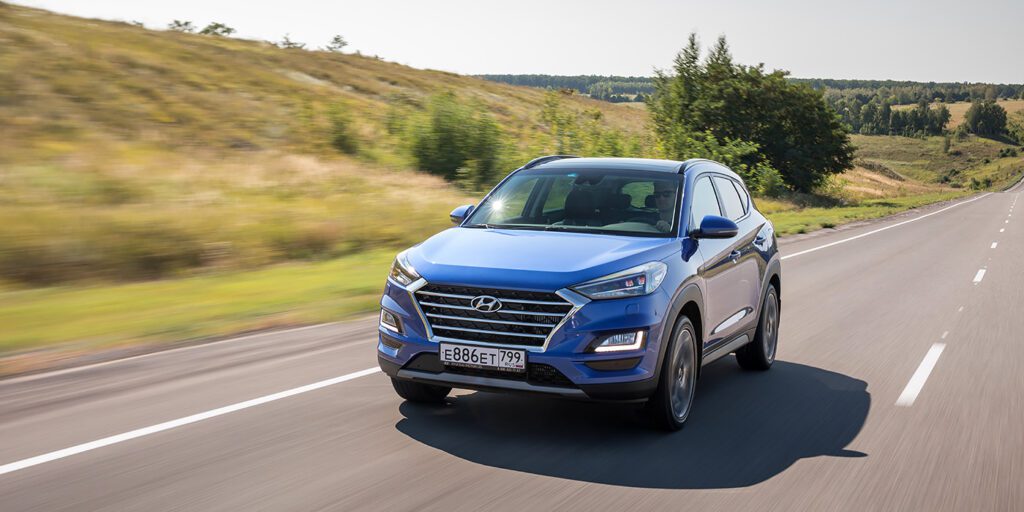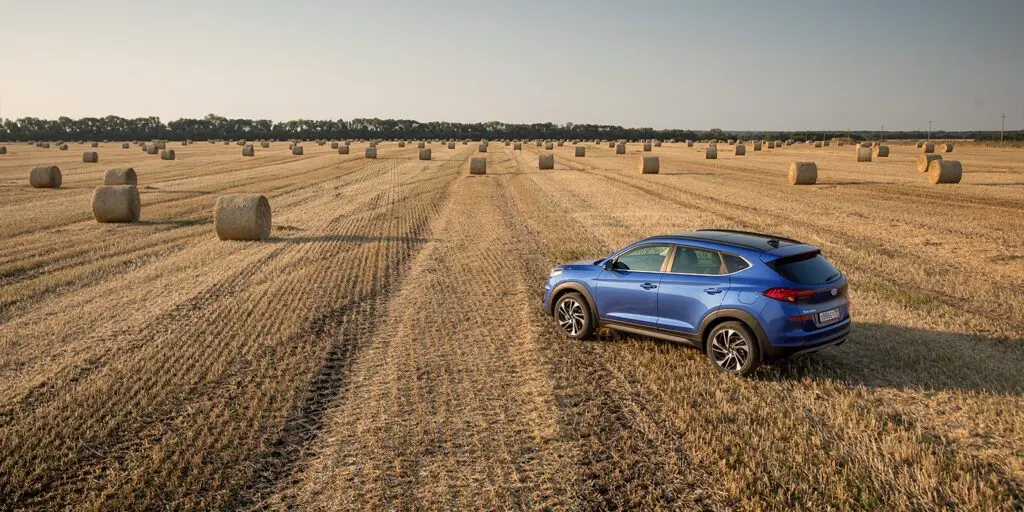
Test drive the updated Hyundai Tucson
Adaptive cruise control, an eight-speed automatic and a new electronically controlled all-wheel drive system inherited from Genesis premium cars - how the popular Tucson has changed after restyling
“Oh, Hyundai lovers club,” the cheerful girl greeted the journalists returning to the top ten lined up crossovers. She apparently did not dare to read the word Tucson aloud.
In fact, thanks to Hyundai marketers for abandoning the alphanumeric and therefore militaryless ix2015 designation in 35, returning the name "Tucson" to the SUV. Better to be an Arizona city with a hard-to-read name than just "thirty-fifth".
The car turned out to be completely different from its predecessor - outwardly as bland as its name. Three years have passed since the debut of the third-generation Hyundai Tucson, and now a crossover has appeared in Russia, which has undergone an intermediate modernization.

At the first meeting, you will probably hardly distinguish a new product from a pre-styling version. But taking a closer look, it can be noted that Tucson has acquired features that make it akin to the new generation Santa Fe, which is one step higher, the sales of which, by the way, have already started in Russia.
At the front, there is a modified grille with sharper corners and an additional horizontal bar in the middle. The shape of the head optics has slightly changed, where new units of L-shaped LED running lights were used, and high-beam headlights with LED elements became available as an option.
At the rear, the changes are not so obvious, but still the updated crossover can be distinguished from its predecessor by the tailgate of a different shape, smoother headlights and a modified shape of the exhaust pipes. Finally, new design wheels are available, including 18-inch wheels.
Inside, the first thing that catches the eye is the screen of the infotainment complex, which was pulled out from the center of the front panel and moved up, enclosing it in a separate block. Now this is a fairly common solution that improves visibility - the amplitude of the driver's pupils from the screen to the road and vice versa is minimized. Plus, this layout allowed for wider air vents, which are now located under the display, rather than on the sides.

The rear passengers now have an additional USB port at their disposal, and on the top versions there is a leather trim for the front panel, multimedia with support for Apple CarPlay and Android Auto, as well as a wireless charging station for mobile gadgets.
As before, the base engine is a two-liter aspirated gasoline engine producing 150 hp. and 192 Nm of torque, which was slightly reprogrammed by the electronic control unit (maximum torque is available at 4000 rpm instead of the previous 4700 rpm). This engine remains the most common in the lineup, despite the rather mediocre acceleration dynamics - especially at speeds in the range from 80 to 120 km per hour.

Much more fun is the 1,6-liter 177-horsepower (265 Nm) supercharged "four" in tandem with a seven-speed "robot". The engine with a turbine and a preselector with two clutches, providing much faster shifting, accelerates the crossover from zero to “hundred” in 9,1 seconds. - almost three seconds faster than the 150-strong version with "automatic" and four-wheel drive.
The top unit is a high-torque two-liter diesel engine producing 185 hp. and 400 Nm of torque. At the same time, the six-speed box was replaced by a new eight-band "automatic" with a modernized torque converter with a package of four discs. Two additional gears provide a 10 percent increase in gear ratio range, which has a positive impact on dynamics, noise levels and fuel consumption.

Front-wheel drive is only available on vehicles with the base unit - all other crossovers are only available with the new HTRAC all-wheel drive system, which debuted on premium Genesis vehicles. It uses an electro-hydraulic clutch that automatically distributes torque between the front and rear axles, depending on road conditions and the selected driving mode. For example, when the selector is shifted to the Sport position, more traction is transferred to the rear axle, and when passing sharp turns, the wheels from the inside begin to brake automatically.
Plus, Tucson can now move with an even distribution of traction to both axles at speeds up to 60 km / h - the predecessor had a full clutch lock disabled when crossing the 40 km per hour line.
"Tucson" briskly walks along a dusty swaggering country road and easily climbs steep hills, but the city crossover should not look for more serious adventures on its 182 mm ground clearance. And mud scabs are unlikely to be combined with smart chrome elements.

When an image of a hot cup appears on the central display of the tidy, it seems as if the navigator prompts you to approach a gas station, where an invigorating drink is prepared from fried beans. In fact, the electronics, which detected frequent crossings of the dividing lines without turning on the turn signal, begins to worry about the degree of driver concentration.
Along with the fatigue control function, the updated Tucson received an expanded set of Smart Sense safety systems. Adaptive cruise control, automatic switching from high beam to low beam, were added to the monitoring of "dead" zones, the function of braking in front of an obstacle in front and compliance with the lane of movement.
After restyling, the basic version of Hyundai Tucson has risen in price by $ 400, to 18. For this money, the buyer will receive a crossover with a 300-horsepower engine, manual transmission and front-wheel drive. The company claims that this is not just a fictional advertising option and that such a car can indeed be ordered. However, the most running version, as before, should be a car with the same engine, six-speed "automatic" and four drive wheels. This "Tucson" will cost $ 150.
A crossover with a 185-horsepower diesel engine and a new eight-band "automatic" costs from $ 23 and with a gasoline turbo engine and a "robot" - from $ 200. For cars in the maximum performance of High-Tech plus with smart cruise control, frontal collision avoidance, wireless charging for smartphones, panoramic roof and seat ventilation, you will have to pay at least $ 25 and $ 100, respectively.
| A type | ||
| Crossover | Crossover | Crossover |
| Dimensions (length / width / height), mm | ||
| 4480/1850/1655 | 4480/1850/1655 | 4480/1850/1655 |
| Wheelbase, mm | ||
| 2670 | 2670 | 2670 |
| Ground clearance, mm | ||
| 182 | 182 | 182 |
| Cargo space, l | ||
| 488-1478 | 488-1478 | 488-1478 |
| Curb weight, kg | ||
| 1604 | 1637 | 1693 |
| Gross vehicle weight, kg | ||
| 2150 | 2200 | 2250 |
| engine's type | ||
| Petrol 4 cylinder | Petrol 4-cylinder, supercharged | Diesel 4-cylinder, supercharged |
| Working volume, cubic meters cm | ||
| 1999 | 1591 | 1995 |
| Max. power, h.p. (at rpm) | ||
| 150/6200 | 177/5500 | 185/4000 |
| Max. cool. moment, Nm (at rpm) | ||
| 192/4000 | 265/1500-4500 | 400/1750-2750 |
| Drive type, transmission | ||
| Full, 6AT | Full, 7DCT | Full, 8AT |
| Max. speed km / h | ||
| 180 | 201 | 201 |
| Acceleration from 0 to 100 km / h, s | ||
| 11,8 | 9,1 | 9,5 |
| Fuel consumption (mixture), l / 100 km | ||
| 8,3 | 7,5 | 6,4 |
| Price from, USD | ||
| 21 600 | 25 100 | 23 200 |
